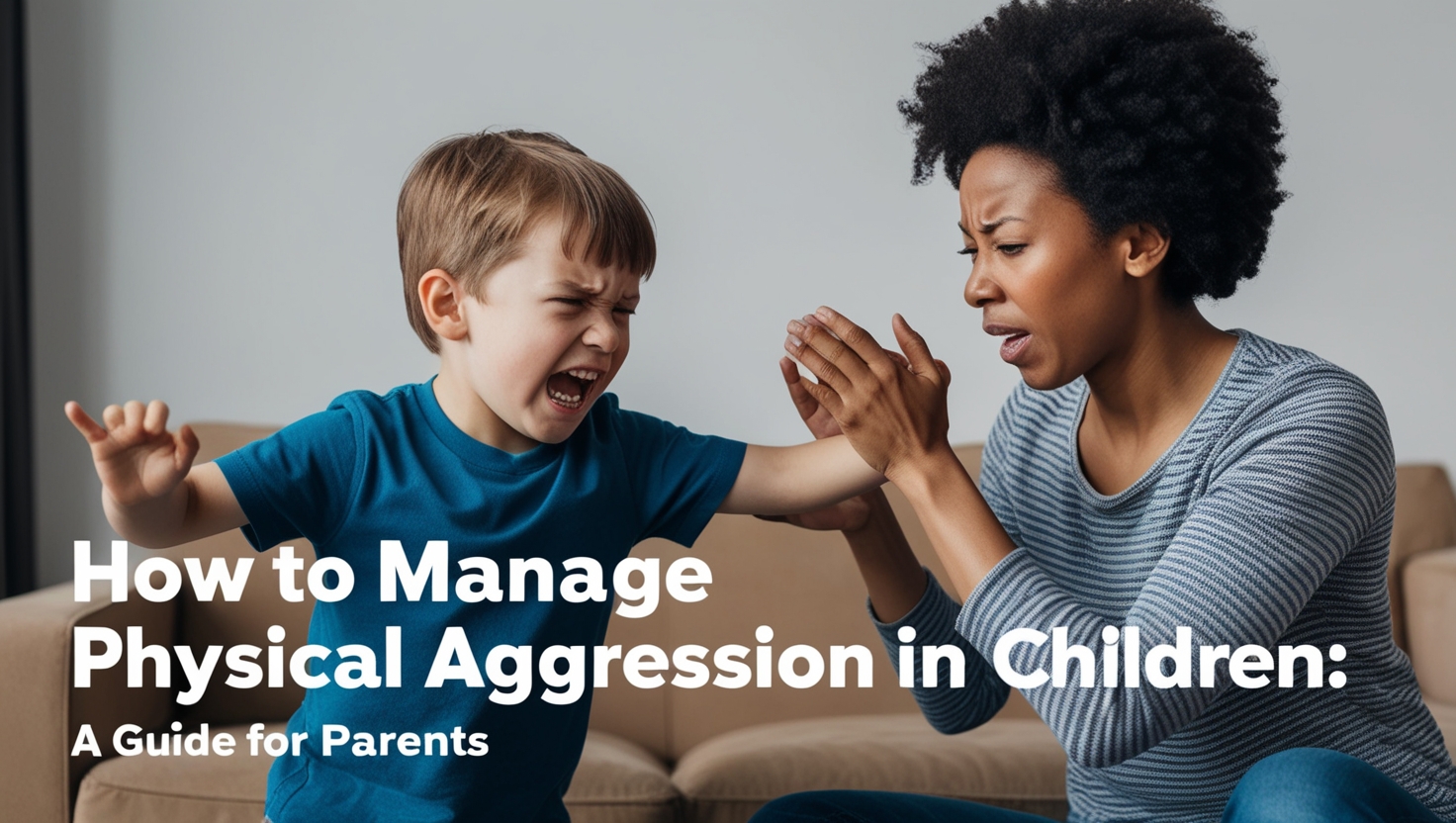Physical aggression in children can be a challenging behaviour for parents to navigate. Understanding the underlying causes and implementing evidence-based strategies can help parents foster a safer and more supportive environment for their children. This guide provides detailed psychological approaches grounded in research to manage and reduce physical aggression in children.
Understanding Physical Aggression
Physical aggression includes behaviours such as hitting, kicking, biting, or throwing objects with the intent to cause harm. Psychological research identifies several potential causes:
- Developmental Stages: According to Jean Piaget’s theory of cognitive development, younger children in the preoperational stage often struggle with emotional regulation, leading to impulsive behaviours like aggression.
- Emotional Dysregulation: Research by Eisenberg et al. (2010) highlights that children with poor emotional regulation skills are more likely to exhibit aggressive behaviours.
- Environmental Influences: Bandura’s Social Learning Theory underscores that children exposed to aggressive models (e.g., through media or home environments) may imitate those behaviours.
- Underlying Conditions: Studies show that neurodevelopmental disorders such as ADHD or autism spectrum disorder often co-occur with aggression due to difficulty managing sensory overload or frustration (Matson & Rivet, 2008).
Strategies for Parents
The following strategies are supported by psychological research and clinical studies:
1. Stay Calm and Model Emotional Regulation
Research by Gottman et al. (1996) indicates that parental modelling of emotional regulation significantly influences children’s ability to manage emotions. To implement this:
- Use a calm tone, even during intense situations.
- Avoid reacting impulsively; take deep breaths to demonstrate control.
- Verbalise your own emotional coping strategies (e.g., “I’m feeling frustrated, so I’ll take a moment to breathe”).
2. Identify and Address Triggers
Bronfenbrenner’s Ecological Systems Theory suggests that external and internal factors impact child behaviour. To identify triggers:
- Observe and document patterns in your child’s behaviour.
- Use tools like the Functional Behaviour Assessment (FBA) to pinpoint antecedents and consequences.
- Address underlying causes, such as hunger, fatigue, or sensory overload.
3. Teach and Reinforce Emotional Literacy
Goleman’s Emotional Intelligence framework emphasises the importance of recognising and labelling emotions. Effective strategies include:
- Using emotion flashcards or storybooks to teach emotional vocabulary.
- Practising role-playing scenarios to help children rehearse appropriate responses.
- Encouraging children to identify emotions in themselves and others.
4. Apply Behavioural Interventions
Research-based behavioural techniques such as those in Applied Behaviour Analysis (ABA) can reduce aggression:
- Use positive reinforcement to increase desirable behaviours. For example, reward calm responses with praise or tokens.
- Implement differential reinforcement by ignoring minor aggressive behaviours while rewarding non-aggressive alternatives.
- Apply time-out procedures as a non-punitive method to help children self-regulate.
5. Establish Clear Rules and Consistent Consequences
Children thrive on predictability, as highlighted in research by Patterson’s Social Interaction Learning model:
- Clearly communicate household rules regarding aggression (e.g., “We use gentle hands”).
- Use logical consequences tied directly to the behaviour (e.g., if a toy is thrown, it is temporarily taken away).
- Ensure consequences are immediate and proportionate.
6. Strengthen Parent-Child Attachment
Attachment theory, developed by Bowlby, indicates that secure attachments reduce aggressive behaviours. Strategies to build attachment include:
- Spending quality one-on-one time with your child daily.
- Using reflective listening to validate their emotions.
- Offering physical affection like hugs to reinforce emotional safety.
7. Promote Self-Regulation through Cognitive-Behavioural Techniques
Cognitive-behavioural interventions, as detailed in Beck’s CBT model, can help children manage impulsive behaviours:
- Teach children to identify and challenge negative thought patterns (e.g., “I’m bad”).
- Introduce techniques such as “Stop, Think, and Act” to encourage thoughtful responses.
- Use mindfulness exercises to reduce emotional arousal.
8. Seek Professional Support When Necessary
Persistent or severe aggression may require professional intervention:
- A child psychologist can conduct comprehensive assessments using tools like the Child Behaviour Checklist (CBCL).
- Therapies such as Parent-Child Interaction Therapy (PCIT) or Trauma-Focused Cognitive Behavioural Therapy (TF-CBT) have shown efficacy in reducing aggression (Thomas & Zimmer-Gembeck, 2007).
- Collaborate with educators to develop Individualised Behaviour Plans (IBPs) tailored to your child’s needs.
What to Do When Your Child is Hitting You
When faced with physical aggression, it is crucial to address the behaviour immediately while maintaining emotional composure. Psychological research provides the following guidelines:
- Ensure Safety First:
- If the aggression poses a threat to you or others, create physical space. Move away or use gentle physical guidance to prevent harm.
- Remove objects that could be used as weapons.
- Stay Calm and Avoid Retaliation:
- Children are likely to escalate their behaviour if they sense anger or fear. Speak in a firm but calm tone.
- Avoid physical punishment, as research (Gershoff & Grogan-Kaylor, 2016) shows it can increase aggression over time.
- Set Clear Boundaries:
- Use simple, direct language to communicate that hitting is unacceptable (e.g., “Hitting hurts. We don’t use our hands to hurt others”).
- Follow through with consistent consequences, such as a time-out or removal from the situation.
- Redirect the Behaviour:
- Offer alternatives to hitting, such as squeezing a stress ball or using words to express anger.
- Model these behaviours by showing your child how to express frustration appropriately.
- De-escalate the Situation:
- Use distraction or humour to diffuse tension.
- Guide your child to a calm-down area where they can self-soothe.
- Discuss the Incident Afterwards:
- Once your child is calm, talk about the incident. Help them understand why hitting is not acceptable and discuss alternative actions.
- Use reflective questioning (e.g., “What could you do next time you feel angry?”).
- Reinforce Positive Behaviours:
- Praise and reward non-aggressive behaviours, especially when your child handles frustration well.
- Reinforce the use of appropriate coping strategies during challenging situations.
- Seek Support if Needed:
- If hitting persists, consider family therapy to explore underlying dynamics and develop tailored interventions.
- Collaborate with teachers or caregivers to ensure consistent responses across environments.
Evidence-Based Preventative Measures
Prevention is a crucial component of managing physical aggression. Psychological research offers several proactive strategies:
- Enhance Emotional Intelligence: Programmes like PATHS (Promoting Alternative Thinking Strategies) have demonstrated effectiveness in teaching children emotional and social skills.
- Encourage Physical Activity: Studies by Hillman et al. (2009) show that regular exercise reduces aggression by lowering stress hormones.
- Limit Exposure to Aggression: Monitoring and setting boundaries on violent media consumption can prevent imitation of aggressive behaviours (Anderson & Bushman, 2001).
- Foster Problem-Solving Skills: Teach children conflict resolution strategies, such as negotiation or compromise, to reduce reliance on aggression.
Conclusion
Managing physical aggression in children requires a comprehensive, evidence-based approach. By combining psychological insights with practical strategies, parents can support their children in developing healthier ways to express emotions and interact with others. Remember, professional guidance is invaluable when challenges persist. Through patience, consistency, and informed intervention, families can foster positive developmental outcomes.





